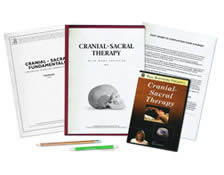

Working with infants and children is very rewarding. Working with the Arizona Breastfeeding center in Tempe, Arizona has provided me the opportunity to work with this special population. This article will accomplish two goals.
- First, emphasize important factors and considerations when working with infants and children.
- Second, highlight five cranial sacral therapy techniques to alleviate digestive conditions common to infants and children.
Conditions that can be alleviated with the usage of cranial sacral techniques include:
- colic
- nausea
- vomiting
It has been my experience that when a child says phrases such as “my tummy hurts” or “my tummy feels weird,” if there is no physical cause then the child is expressing anxiety. Children may not have the vocabulary to express words such as “anxiety” but their body may reveal long-held anxiety syndromes with chronic digestive pain.
Avoid using bodywork or massage techniques while a client is in the acute phrases of illness. Once the acute phase has passed, then begin bodywork or massage regiment. Before beginning cranial sacral techniques, ensure no signs of increased intracranial pressure (ICP).
Classic ICP manifestations include:
- blurry vision
- headaches (dull, encompassing whole cranium)
- nausea
- vomiting
- elevated blood pressure
- confusion
- changes in behavior
Sessions with infants and children may last only 10-20 minutes. This is adequate time to accomplish the goals of cranial sacral therapy, especially with relaxing the central nervous system.
How to Create an Inviting Environment for Children and Infants
A warm, inviting environment can help an infant or child better receive bodywork efforts.
- Examine the lighting of the room as lights that are too bright can be distracting.
- Keep decorative items to a minimum.
- Have age appropriate music playing in the background. Younger children may appreciate classic tunes from their favorite cartoons whereas older children may like contemporary music.
- Having toys that are easy to clean available may be useful for children who are highly tactile. These may include larger sized plastic or rubber toys.
- Hardcover books can also be a good option.
- Generally, electronics should be avoided to diffuse the distracting nature of these devices.
- Allow for adequate space in the room for adults to remain present.
- Create floor space for adults to lay down items as needed upon a blanket or rug.
For all these suggestions, inquire with the parents/caretakers of the infant or child to determine best choices. They will know best for their child!
Also inquire with the adults involved what their child likes or dislikes with touch. Mimicking healthy and positive touch already offered by the parents or caregivers will allow the therapist to be better received quickly by the infant or child.
Preparing Your Massage Table
Preparing your massage table will be an important step in working with infants and children sufficiently. Consider the color, texture and presentation of linens and towels. Cartoon or superhero themed linens can be appealing to children. Ensure two layers of towels upon your linens when working with infants, as babies can be expected to eliminate freely upon your table.
Here are five technique holds to alleviate digestive dysfunction and restore balance of the cranial sacral system within infants and children.
1. Sphenoid Decompression
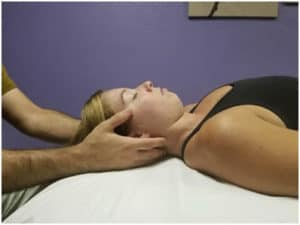
This technique involves gently placing the thumbs upon the temples. With only five grams of pressure (approximately the weight of a nickel), the therapist tractions the skin and fascia in an anterior direction. This pushes the sphenoid ala (wings) towards the ceiling.
What to Feel: A practitioner may feel the sphenoid alas spiral or move in circular directions. This movement indicates the sphenoid bone is off alignment. The therapist can feel alignment restored when the sphenoid bone can be sensed to move in an anterior—posterior manner.
2. Parietal Decompression
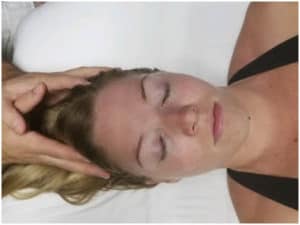
The practitioner locates the ridges along the superior-lateral aspects of the skull. When located, fingertips hook lightly into these ridges allowing the grip to gently traction the parietal bones superior. This action pulls these bones towards the therapist.
What to Feel: A practitioner may feel the parietal bones shift left to right indicating the bones are moving in asymmetric fashion. The therapist can feel alignment restore when these bones move in a superior—inferior manner.
3. Temporal Decompression
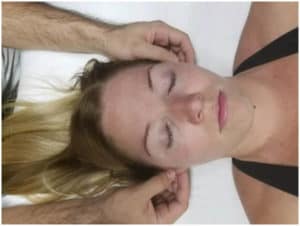
The practitioner uses a soft finger grip to hook upon the hard ring of cartilage within the pinna (flap) of each ear. When located, a gentle pull in a lateral direction guides the ears directly away from the skull.
What to Feel: A practitioner may feel the ears moving in spiral, superior or inferior manners indicating the temporal bones are misaligned. The therapist can feel alignment restore when these bones in a lateral—medial manner.
4. Mandible Decompression
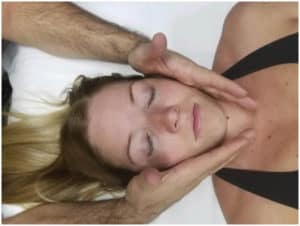
This technique involves the therapist placing their palms at the angle of the jaw on either side, finger surfaces along the jawline with fingertips pointing towards the chest at the chin level. A gentle traction in an inferior direction guides the bone towards the feet.
What to Feel: A practitioner may feel the mandible bone shift side to side or in spiral movements indicating bone misalignment. The therapist can feel realignment restored when the jaw is felt to move an inferior—superior manner.
5. Frontal Decompression
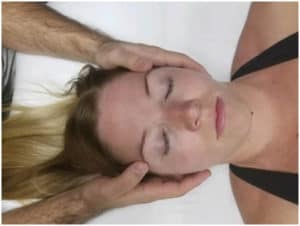
The practitioner places thumbs gently upon the lateral ridge of the frontal bone. Usually this lies in alignment with the lateral edge of either the eyebrows or eye sockets. Once felt, thumbs can be gently hooked upon these ridges while therapist guides the bone in an anterior direction. This will guide the bone towards the ceiling.
What to Feel: A practitioner may feel the sphenoid alas spiral or move in circular directions. This movement indicates the sphenoid bone is off alignment. The therapist can feel alignment restored when the sphenoid bone can be sensed to move in an anterior—posterior manner.
Ethmoid Visualization
At the end of any therapeutic session, performing a grounding hold will help the body assimilate the bodywork session more effectively. Here is an easy grounding hold for infants and children to receive.
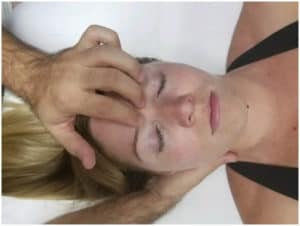
The practitioner supports the head with one hand while guiding energy into the fingers placed either atop or hovering above the superior edge of the nose bridge (also termed the “third eye” region).
These cranial sacral techniques along with a warm, inviting environment can facilitate great healing amongst infants and children. Even sessions as short as 10 minutes can yield profound results.



